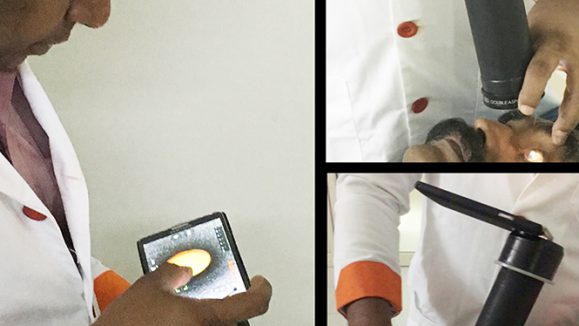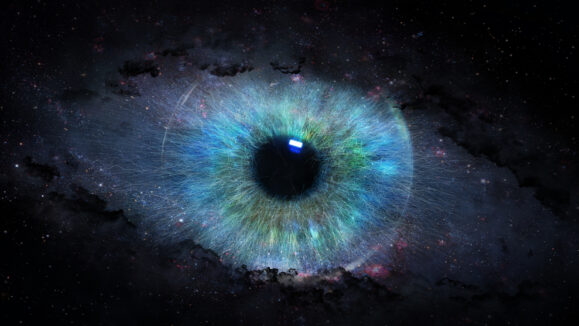At the EURETINA 2018 congress, Janis Eells, Ph.D. and professor from the University of Wisconsin-Milwaukee, USA, provided a summary of the tremendous amount of work that has been done over the last 15 years toward better understanding the mechanisms of photobiomodulation.
Photobiomodulation is the process by which we obtain a biochemical reaction specifically by exposure to light. Following light absorption, photons stimulate mitochondrial cytochrome oxidase and turn on, via transcription factors, specific gene expression and protein synthesis.1
According to Dr. Eells, mitochondrial dysfunction plays a key role in cellular aging and degenerative disease. And in the retina, mitochondrial dysfunction is a contributing factor in the pathogenesis of retinitis pigmentosa (when mutations in the MT-ATP6 gene affect protein structure2), glaucoma, age-related macular degeneration (AMD) and diabetic retinopathy (DR). Ultimately, this progressive mitochondrial dysfunction results in oxidative damage, retina cell death and blindness.
Dr. Eells explained that photoreceptors are highly active metabolically and are very vulnerable to oxidative stress. “Therefore, protection against mitochondrial dysfunction and oxidative stress in the retina is extremely important,” she said.
In relation to oxidative stress, an animal study on the mechanism of photobiomodulation indicated that low-level light therapy increases the proliferation of reactive oxygen species (ROS) in normal cells. However, when aimed at cells which are oxidatively stressed, the ROS levels are decreased, thereby reducing oxidative stress. Similarly, in inflammatory cells, it has been shown to produce an anti-inflammatory effect and reduce reactive nitrogen species and prostaglandins in animal models as well. What’s more, photobiomodulation is said to affect the cell’s metabolism when general hemoproteins and cytochrome c oxidase (COX) absorbs the low-level light.3 In another study, the reprogramming of the photoreceptor’s metabolism offered a “survival advantage” for photoreceptors.4
As a reversible inhibitor of cytochrome oxidase, formic acid also plays a role in mitochondrial dysfunction. Dr. Eells and colleagues have shown that in animals, this can be reversed by photobiomodulation. Furthermore, in a rat model of retinitis pigmentosa, light treatment resulted in significant improvements in retinal function, and photoreceptor cell numbers.
In an animal model of AMD, Dr. Eells and colleagues have also shown that specific wavelengths of light are protective against AMD, as shown by retinal cell numbers and functionality.
“Randomized controlled trials will be needed to confirm these effects in human patients,” Dr. Eells noted.
To discuss the safety and efficacy of photobiomodulation in dry AMD subjects, Samuel N. Markowitz, M.D., director of the Low Vision Rehabilitation Program, Department of Ophthalmology, University of Toronto, Canada, on behalf of the study team, presented findings from the recently completed LIGHTSITE 1 trial.
LIGHTSITE 1 was a clinical trial that assessed the safety, tolerability and efficacy of photobiomodulation in subjects with dry AMD.
In the trial, 30 patients were randomized into two groups to receive either standard of care treatment for dry AMD plus photobiomodulation treatment with the LT-300 system (LumiThera, Washington, USA), or standard of care treatment for dry AMD plus sham treatment with the LT-300 system. The study’s primary outcome measure was visual acuity changes from baseline to month 12, while the secondary outcome measure was contrast sensitivity.
Patients with dry macular degeneration in the study eye and best corrected visual acuity between 20/40 and 20/200 were included. Study participants were also required to provide consent.
The study excluded patients with visually significant cataracts, presence of a visually significant posterior capsule (if prior cataract surgery has been performed), and patients with any visually significant disease process in any ocular structure that would affect vision, unrelated to macular degeneration. Also excluded were patients with severe clinically significant disease or unstable medical disorders including cardiovascular, hepatic, renal, neurological, endocrine, and gastrointestinal, CNS or life-threatening disease or current malignancy at the discretion of the investigators.
The patients were treated with photobiomodulation to the retina at specific wavelengths to the eye three times a week for three weeks, repeated at six months and underwent follow-up for up to 12 months.
Visual acuity (VA) was measured using ETDRS VA letter scoring to test the difference between the sham and treatment subjects in mean change from baseline to month 12. Contrast sensitivity was measured using the FACT Contrast Sensitivity Chart to test the difference between the sham and treatment subjects from baseline to month 12. The study team also utilized questionnaires to assess the quality of life of patients following photobiomodulation treatment.
Dr. Markowitz concluded that “photobiomodulation treatment in patients with dry AMD resulted in statistically significant improvements in visual acuity over the course of 12 months as compared to the sham treatment, improved contrast sensitivity and quality of life with no associated safety concerns”.
Consultant ophthalmologist Dr. Igor Kozak from Moorfields Eye Hospital Centre in the United Arab Emirates further explained how this treatment, which has no thermal effects, works. “Photobiomodulation is also known as near infrared (NIR) light therapy which has been shown to increase cellular metabolism, energy supply and metabolic repair processes5,” he said.
“Its application to dysfunctional RPE in diseases such as age-related macular degeneration (AMD) is being hypothesized to restore function and attenuate the pathogenesis of AMD. It is believed that the effect is mediated via neutralizing reactive oxygen species from oxidative stress to mitochondria6,” Dr. Kozak continued.
“AMD has been a clinical target for photobiomodulation therapy. The pivot clinical studies of photobiomodulation in AMD patients have reported some encouraging improvements7,” he said, adding it was hoped the results from the completed LIGHTSITE trial in Canada would help establish effective treatment parameters.
Editor’s Note: The Joint EURETINA-ESCRS 2018 Congress was held in Vienna, Austria, on September 20-26, 2018. Reporting for this story also took place at EURETINA-ESCRS 2018. Dr. Kozak was generous enough to contribute on this story, but he was not a part of the mentioned studies.
References:
1 Geneva II. Photobiomodulation for the treatment of retinal diseases: a review. Int J Ophthalmol. 2016;9(1):145-152.
2 Rai PK, Russell OM, Lightowlers RN, Turnbull DM. Potential compounds for the treatment of mitochondrial disease. Br Med Bull. 2015;116:5-18.
3 Kim, H. P. Lightening up Light Therapy: Activation of Retrograde Signaling Pathway by Photobiomodulation. Biomol Ther (Seoul). 2014; 22(6): 491–496.
4 Wubben TJ, Pawar M, Smith A, et al. Photoreceptor metabolic reprogramming provides survival advantage in acute stress while causing chronic degeneration. Sci Rep. 2017; 7(1):17863
5 Karu T. Mitochondrial mechanisms of photobiomodulation in context of new data about multiple roles of ATP. Photomed Laser Surg. 2010;28:159–160.
6 Fuma S, Murase H, Kuse Y, et al. Photobiomodulation with 670 nm light increased phagocytosis in human retinal pigment epithelial cells. Mol Vis. 2015;21:883-892. 7 Merry GF, Munk MR, Dotson RS, et al. Photobiomodulation reduces drusen volume and improves visual acuity and contrast sensitivity in dry age-related macular degeneration. Acta Ophthalmol. 2017;95:e270–7.




